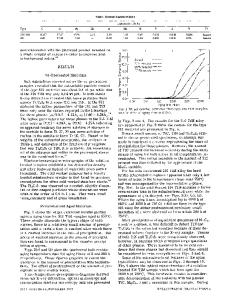Mechanisms of deformation-induced grain boundary chromium depletion (sensitization) development in type 316 stainless st
- PDF / 5,920,791 Bytes
- 18 Pages / 597.28 x 785 pts Page_size
- 100 Downloads / 309 Views
I.
INTRODUCTION
T H E R M O M E C H A N I C A L processing and fabrication treatments used to produce commercial materials range from simple isothermal annealing treatments to complex multipass welding operations. These thermomechanical treatments induce thermal and strain cycles in the material, Which interact with the existing material condition, resulting in the final microstructure and microchemistry of the product. The achievement of desired properties in the product is critically dependent on an understanding of thermomechanical treatment effects A.H. ADVANI, Coordinator for Research and Technology Transfer, Institute for Manufacturing and Materials Management, and Adjunct Assistant Professor, Department of Metallurgical and Materials Engineering, and L.E. MURR, Mr. and Mrs. Macintosh Murchison Professor and Chairman, Department of Metallurgical and Materials Engineering, are with the University of Texas at El Paso, E1 Paso, TX 79968. D.G. ATI'ERIDGE, Associate Professor, is with the Department of Materials Science and Engineering, Oregon Graduate Institute of Science and Technology, Beaverton, OR 97006. R. CHELAKARA, Graduate Student, is with the Department of Materials Science and Engineering, University of Texas at Austin, Austin, TX 78712. Manuscript submitted October 22, 1990. METALLURGICAL TRANSACTIONS A
on microstructure and microchemistry development. Research on these phenomena is important for improvement of material reliability and performance in service. Stainless steels (SS) offer a simple system of commercial interest where the effects of thermomechanical treatment on microstructure and microchemistry development can be studied. Stainless alloys are susceptible to precipitation of chromium-rich carbides and development of grain boundary chromium depletion (GBCD), or sensitization, during thermomechanical processing and fabrication operations. ~ The induction of sensitization has been a recurring cause for intergranular corrosion and intergranular stress corrosion cracking of primary and secondary power plant components for many years and is also now being recognized as a potential cause for failure of SS containers used for storage and transport of nuclear and toxic waste materials, t2~A fundamental evaluation of the influence of thermomechanical treatment on GBCD in stainless steels is thus vital for assessing intergranular corrosion and intergranular stress corrosion cracking in SS and better understanding microstructuremicrochemistry-property relationships in materials. While thermal effects on sensitization in SS have been studied for a range of isothermal and continuous cooling VOLUME 22A, DECEMBER 1991--2917
heat treatments, research on strain-induced sensitization has only been performed for limited strain and heattreatment schedules. Initial evaluation of deformation effects on sensitization was performed by Bain et al. Ill for type 304 SS strained to 50 to 55 pct. Results of Bain et al . ' s work indicated that deformation accelerated the development of chromium depletion in SS. Th
Data Loading...











